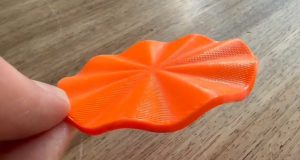Selective Separation Sintering (SSS), a new 3D-printing process developed by Behrokh Khoshnevis to enable the construction of physical structures in space won first place in the NASA In-Situ Materials Challenge. The competition was held in collaboration with the Kennedy Space Center and Swamp Works to advance construction and human habitation in space.
How else can we further space exploration, mused Khoshnevis, the two-time NASA competition winner, Dean’s Professor of Industrial & Systems Engineering, Aerospace & Mechanical Engineering and Astronautics Engineering, and the Director of the Center for Rapid Automated Fabrication Technologies (CRAFT) other than building landing pads, roads, hangars, blast walls and radiation shields on the Moon and on Mars?
It’s too expensive to rely on materials sent from earth to build in space. In addition, using resources found in space could save considerable time.
The NASA competition mandated that competitors identify novel concepts in advancing the technology and methodology of utilizing materials found on Moon and Mars – regolith, crushed basalt rock or others – to construct structures or fabricate objects needed for future planetary and space missions.
Using synthetic material created by the Johnson Space Center that mirrors the existing gravel and material available on the Moon and Mars, Khoshnevis and his team developed “a robotic fabrication process” that uses high melting point ceramics such as magnesium oxide (readily available on the Moon and Mars) and ordinary regolith (planetary soil) to produce tiles that could withstand the heat and pressure of exhaust plume of landing spacecraft.
Selective Separation Sintering (SSS) says Khoshnevis, “is a novel powder based additive manufacturing method that can build parts of various scale out of polymers, metals, ceramics and composites.”
The new SSS process builds on Khoshnevis’ existing Contour Crafting process, a mega-scale 3D printing process, which won a grand prize in a 2014 NASA competition. Khoshnevis demonstrated in a NASA Innovative Advanced Concept (NIAC) research project that Contour Crafting can use a mix of sulfur and regolith to build structures such as walls and hangers on the moon and Mars. While Contour Crafting is an extrusion based 3D Printing process, which is suitable for construction of large-scale monolithic structures, SSS is a powder-based method which is ideal for building smaller scale objects such as inter-locking tikes and bricks , as well as a large array of functional objects such as metallic parts.
“SSS is the only powder-based process that can effectively work in zero gravity condition, and as such it is ideal for use in the International Space Station for fabrication of spare parts and tools., “says Khoshnevis.
According to Khoshnevis, it costs about $10,000 to launch a kilogram into low Earth orbit, $100,000 to send the same load to the Moon and even more to send this cargo to Mars. He estimates that his team’s innovation could reduce the need for sending cargo from earth thus could save agencies such as NASA considerable funds.
“It could make space pioneering more cost-effective and feasible,” said Khoshnevis.
“There are no viable, direct, high temperature metal, ceramic or composite fabrication methods that can work in zero-gravity conditions. SSS will be the first such process,” Khoshnevis added.
Khoshnevis believes the SSS process his team created offers certain advantages, including speed, independence from expensive laser and electron beam technologies (and perhaps greater accuracy than these methods).
“There is high potential for the space and planetary use of this technology. SSS is a minimally complex but highly capable technology that can effectively assist planetary exploration, utilization and colonization,” he says.
The research team plans to further test the SSS process in USC’s Astronautics Rocket Lab vacuum chamber and NASA’s Kennedy Space Center facilities. They hope to collaborate with the local aerospace companies in the Los Angeles area.
Subscribe to our Newsletter
3DPResso is a weekly newsletter that links to the most exciting global stories from the 3D printing and additive manufacturing industry.
























